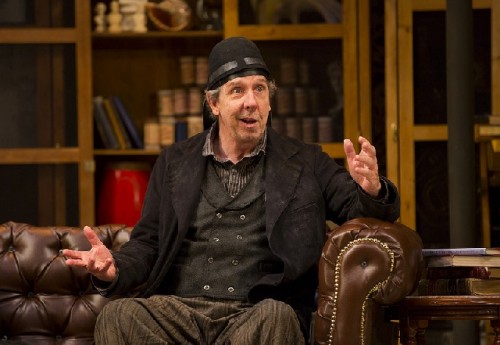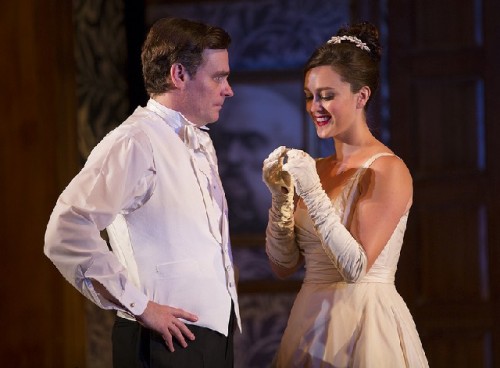Nicholas Martin’s Gorgeous Pygmalion at WTF
Stars Robert Sean Leonard and Heather Lind in Shaw’s Masterpiece
By: Charles Giuliano - Jul 24, 2013
Pygmalion
By George Bernard Shaw
Directed by Nicholas Martin
Scenic Deign, Alexander Dodge; Costume Design, Gabriel Berry and Andrea Hood; Lighting Design, Philip Rosenberg; Sound Design, Drew Levy; Original Music, Mark Bennett; Hair and Wig Design, Cookie Jordan; Dialect and Vocal Coach, Deborah Hecht.
Cast: Maura Hooper (Clara), Patricia Conolly (Mrs. Eynsford Hill), Dan O’Brien (Bystander), Federico Rodriguez (Freddy Eynsford Hill), Heather Lind (Eliza Doolittle), Paxton Whitehead (Colonel Pickering), Robert Sean Leonard (Professor Henry Higgins), Alex Seife (Taxi Man), Caitlin O’Connell (Mrs. Pearce), Don Lee Sparks (Mr. Doolittle), Maureen Anderman (Mrs. Higgins), Ariana Seigel (Parlor Maid), Robert Allan, Eric Began, Brian Evans, Timothy Thompson (Ensemble).
Williamstown Theatre Festival
Main Stage
July 17 to 27
Production originated at Old Globe Theatre in San Diego
It’s been a very good year for former Williamstown Theatre Festival artistic director, Nicholas Martin. On Broadway he was nominated for a Tony Award as Best Director for Christopher Durang’s Vanya and Sonia and Masha and Spike which won a Tony for Best New Play.
In January he directed George Bernard Shaw’s iconic masterpiece Pygmalion (1913), with a twist, at the Old Globe Theatre in San Diego, California. For that production he recruited his friend Robert Sean Leonard, Dr. Wilson in the long running TV series House, as a very different take on the imperious expert on phonetics and scourge of femininity, the confirmed bachelor, Professor Henry Higgins.
That California production, mostly intact with the exception of recasting the essential role of Eliza Doolittle (Heather Lind), has been remounted splendidly to the delight of capacity audiences as one of three plays this season on the Main Stage of the Williamstown Theatre Festival.
While an enduring classic this is hardly a moldy fig, crowd pleasing, summer stock version of the edgy Shaw play. The renowned Irish playright, one of the foremost of his generation, used his work as a vehicle to advance complex social and political agendas. In this case deeply felt theories of proto feminism during an era when women were the pawns and playthings of dominant males.
In his original Pygmalion the main characters, Eliza and Professor Higgins, do not resolve their differences and live happily ever after. Shaw was furious when the initial director altered his ending and thereby sold tickets which has been the case ever since.
In this production Martin mucks about with the final scene which you will have to see for yourself. If you can get a ticket. One may only imagine what Shaw would say about this ambivalent conclusion.
This production underscores why WTF is one of the foremost regional theatres in America.
Start with the stunning set by Alexander Dodge and exquisite period costumes of Gabriel Berry and Andrea Hood. This Pygmalion is simply gorgeous.
Five acts, and as many scene changes, have been compressed to two with an intermission. The evening, however, flew by so blissfully that we could indeed have danced all night.
We start on a busy London street after theatre on a rainy night. The bumbling Freddy (Federico Rodriguez) a surrogate for an air headed, oh so proper bachelor waiting for an inheritance, is dispatched to fetch a cab for his mother (Patricia Conolly) and Clara (Maura Hooper). But none is to be had he announces and is sent packing yet again.
Enter the iconic Cockney guttersnipe and wily, impendent flower girl Eliza Doolittle. She crawls and cavorts about with expressive, ungainly body language to accentuate raggedy, scruffy attire and an awful slaughter of the King’s English. Bloody Hell. (Which shocked the audience during the premiere and infuriated Shaw when it disrupted the performance.)
In the background Higgins is taking notes which concerns Eliza that he may be a Copper. He's a linguist with a specialty in phonetics it seems. As a kind of parlor game he identifies where all the bystanders are from. In London he can locate an accent to a specific street. One such individual, recently returned from India which Higgins nails, is the redoubtable Colonel Pickering (Paxton Whitehead) a fellow linguist specializing in the dialects of India.
They knew each other by reputation and are delighted to connect and compare their research. In fact the bachelors become roommates with that infamous wager that binds them together. The challenge is that Higgins, through teaching Eliza proper diction and manners can pass her off, within six months, as a Duchess at a ball.
Eliza is willing to pay for elocution lessons if it will qualify her for a job in a flower shop.
Pickering as a part of the wager offers to pay for her tuition as well as outfit her and pay for cabs.
The street scene morphs into the Edwardian man cave of Higgins. The interior is a clutter of specimens and artifacts of his scholarly interests. There is a riot of floral wall paper in the style of William Morris and the Arts and Crafts movement. Dodge has provided a staircase to a small organ. A prominent object is a device to record and play cylinders (not long after Edison invented them). For his research Higgins collects examples of dialect and photographs of his subjects.
The transformation of Eliza commences with an order to the housekeeper Mrs. Pearce (Caitlin O’Connell) to give her a good scrubbing and burn her rags. As a proper woman she wants to know the living arrangements and status of their guest. She will not stand for any hanky panky. Or, as Eliza states in a smarmy screed “I is a good girl.”
Precisely.
For Higgins she is just a subject for an experiment. Like so many middle and upper class men of his era, who had their clubs and pubs, he appears to be asexual. That also identifies Pickering who is cast as an older man and arguably menopausal. Bachelors of that time who chose not to marry had their brothels or other men on the sly. Shaw provides no hints to the sexual orientation of Higgins. Leonard is cast as a Higgins young enough to have an interest in Eliza beyond the academic.
For Lind’s Eliza, however, her physical needs are more obvious. Initially she declares, as a street beggar, that “No man will have me.” As a transformed and proper lady, however, her options in that society were limited. Shaw exposes the sexual enslavement of ladies who depend upon, are kept and exploited by men. Initially, she was an independent woman who scratched out a meager living selling flowers. As a “lady” she rails against the indignity of having to sell herself. Higgins, a blatant misogynist, is oblivious to the irony.
But the point is not lost on Higgins’s mother who has looked askance on the social and linguistic experiment. Her son is just impossible and it falls to her lot to protect and shelter a beautiful and vulnerable young woman from a horrible fate.
As Higgins sees it, through his training, he prepared her to be a “consort to a king.” He is miffed that for all of his brilliant work she might become the bride of the worthless and silly twit Freddy. While not love, in a Shavian trope, it is better than being tossed back into the gutter where she no longer belongs.
During the 19th century, and into the time frame of Pygmalion, courtesans enjoyed unique social status although they were never received in the social circles of their patrons. It was generally accepted that Kings had their consorts which is what Higgins appears to project for Eliza. Has he indeed prepared her for the profession? Is he an ersatz pimp? Does he now turn her out without having sampled the wares? Is he a truly asexual bachelor or just a closeted bugger?
Shaw created a wonderfully comic foil and parallel transformation through Eliza’s father, the ineffectual blackmailer. Don Lee Sparks is just delicious in the role to the utter comic delight of the audience. We first encounter him in rags with a foul accent shaking down Higgins to “purchase” wink, wink his daughter for what he perceives to be less than scientific intent.
Through a masterful twist of fate he reappears dressed as an uneasy gentleman. It seems that Higgins recommended him as a oracle of the class struggle to a colleague. Through the quick demise of said gentleman Mr. Doolittle has been named in the will with 3,000 pounds a year to deliver up to five lectures annually.
When Doolittle frets over this fate Pickering quips that after one lecture it is unlikely that he will be burdened by a second.
In reducing Shaw’s five acts to two we miss a lot of the detail that so enriched and fleshed out the magnificent musical My Fair Lady. The second act, for example, starts with Eliza, Higgins and Pickering returning from a complex day of displaying the mysterious duchess culminating in an Ambassador’s Ball.
While Higgins and Pickering mutually celebrate and congratulate each other on the success of their venture we see Eliza sulking in the corner. The evening has been their triumph and not her’s.
She is just an object which they have carved and chiseled like the sculpture of Galatea created by the mythical artist Pygmalion. That sets an unpleasant tone for the second act which is less fun than the first. The transformation was much more entertaining than what now is to become of her. Culminating in the cliff hanger ending.
Shaw intended for us to exit the theater contemplating the exploitation of women. Clearly audiences have a different take on his morality play and directors strive to fill the gap between Shaw as social commentator and entertainer.
Compare, for example, Pygmalion to that other Irish masterpiece Oscar Wilde’s The Importance of Being Earnest which WTF produced last year with a gangster twist by first time director, David Hyde Pierce. At the end of an evening of Wilde's similarly witty and brilliant word play the loose ends are tied up in a bow and everyone lives happily ever after.
Not so with the always more difficult Shaw.
There is much to love and treasure about Martin’s take on Pygmalion not least the superb casting.
It was an interesting choice to recruit the American Leonard to play the British linguist Higgins. We never lose sight that Leonard is an American with little or no hint at a British accent or mannerisms. That’s just fine with us as he brings to the role an understated, charming, accessible interpretation. He leaves us with no doubt as to daunting skills as an actor. Although one snarky critic found too much Dr. Wilson and not enough Dr. House in his role as a sexist curmudgeon. While food for thought I do not agree. Of course we would just Love to see Hugh Laurie play the role.
One might nit pick about Lind’s Eliza. There are lapses, particularly in the second act, but as a young actress she holds her own especially when going head to head in clashes with Higgins. The range of this role made many demands which she rose to with panache.
There were so many wonderful supporting roles, virtually all of the cast. In particular Maureen Anderman brought subtle nuance and grace, a noblesse oblige, to the aristocratic Mrs. Higgins. She set the bar for what Eliza must strive for as a proper lady in London society. Shaw wrote her as a woman who lives within the rules, deals with outrageous alpha males like her impossible son, while retaining style and dignity.
While Leonard is an Americanized Brit, yet again, the superb actor Paxton Whitehead is the perfect signifier of that class conscious, autocratic culture.
God Save the Queen. And hip hip horray to the yet unnamed Royal heir.
Link to interview with Robert Sean Leonard.










